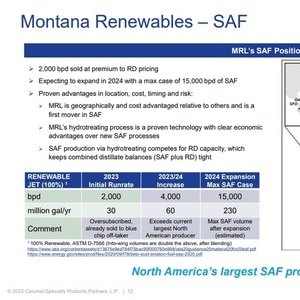Calumet considers pivot to SAF production at Montana facility

November 14, 2022
BY Erin Krueger
Calumet Specialty Products Partners L.P. is considering plans to ramp up sustainable aviation fuel (SAF) production at its Montana Renewables biorefinery to as high as 230 MMgy. That facility, currently focused on renewable diesel production, began commissioning this fall.
Calumet in February 2021 announced plans to produce renewable diesel at its petroleum refinery in Great Falls, Montana , by reconfiguring its oversized hydrocracker to process up to 15,000 barrels per day of renewable feedstocks, producing renewable diesel and SAF. The project is currently undergoing commissioning. A renewable hydrogen plant and feedstocks pretreatment facility are under development and scheduled to begin commissioning this winter.
Advertisement
Advertisement
According to CEO Todd Borgmann, the company is currently focused on taking the time to understand the nuances of operating the renewable diesel unit at the Great Falls facility. The temperature in Great Falls has been roughly 30 degrees lower than normal, so the company is taking it slow, he added.
Information released by Calumet indicates the biorefinery is expected to have 15,000 barrels per day of capacity in place by 2023 and is expected to produce approximately 12,000 barrels per day. Production is expected to include 9,000 barrels per day of renewable diesel, 2,000 barrels per day of SAF and 1,000 barrels per day of renewable naphtha. A planned expansion in 2024 would boost nameplate capacity to 20,000 barrels per day, with production estimated at 12,000 barrels per day of renewable diesel, 4 million barrels per day of SAF, and 1,500 barrels per day of renewable naphtha. Borgmann said the planned expansion will make the company the largest SAF producer in North America. Engineering is also underway to support a project that could optimize the facility for SAF production, boosting SAF capacity to as has high as 15,000 barrels per day, which equates to 230 MMgy.
Advertisement
Advertisement
During the earnings call, Borgmann also discussed feedstock procurement for the plant. The facility is initially expected to take in soybean oil, animal fats and corn oil as feedstocks. The plant will likely also process other feedstocks in the future, including canola oil and camelina. Borgmann indicated the U.S. EPA’s expected approval of canola oil fuel pathways for renewable diesel, jet fuel, naphtha and other associated fuels will benefit Montana Renewables, as canola is already widely cultivated in Montana. He also discussed the emerging potential for camelina, a cover crop also currently grown within the state.
Related Stories
At the University of Missouri, plant biochemist Jay Thelen is using arabidopsis as a powerful model to explore ways to boost oil production — an important step toward creating more sustainable, plant-based energy sources.
Iowa farmers have a new market opportunity for their 2025 soybean crop. Landus is expanding its Clean Fuel Regulation initiative, made possible by recent policy changes expected to increase Canada's demand for liquid biofuel.
Topsoe, a leading global provider of advanced technology and solutions for the energy transition, has been selected as the renewable diesel technology partner for CountryMark’s Mount Vernon, Indiana refinery.
The U.S. exported 35,953.6 metric tons biodiesel and biodiesel blends of B30 or greater, according to data released by the USDA Foreign Agricultural Service on Aug. 5. Biodiesel imports were at 2,148.9 metric tons for the month.
XCF Global leverages Alfa Laval technology to enhance pretreatment capabilities at New Rise Reno facility
XCF Global Inc. on Aug. 5announced it leverages Alfa Laval Inc. pretreatment technology at its New Rise Reno biorefinery, a sustainable aviation fuel (SAF) plant located in Nevada. The pretreatment technology enhances feedstock flexibility at the plant.
Upcoming Events










